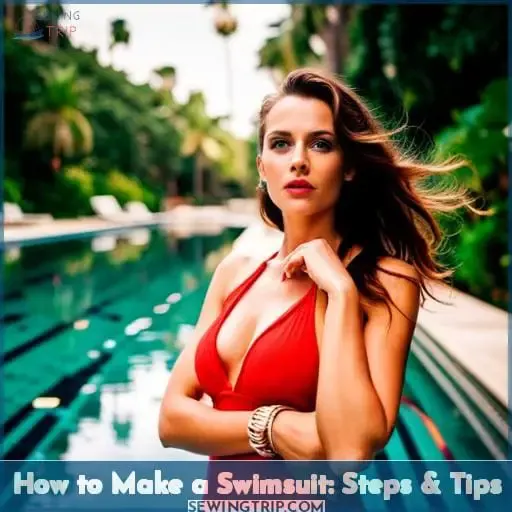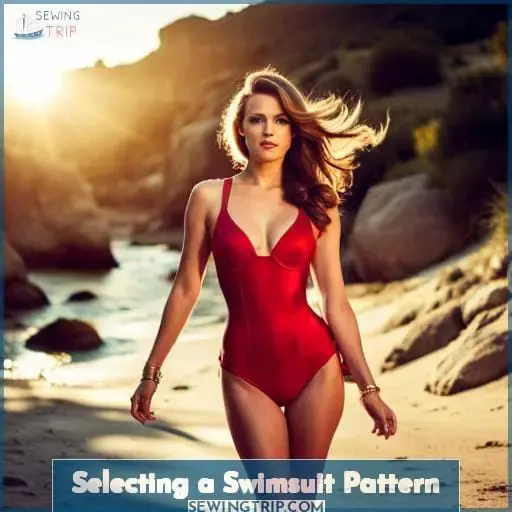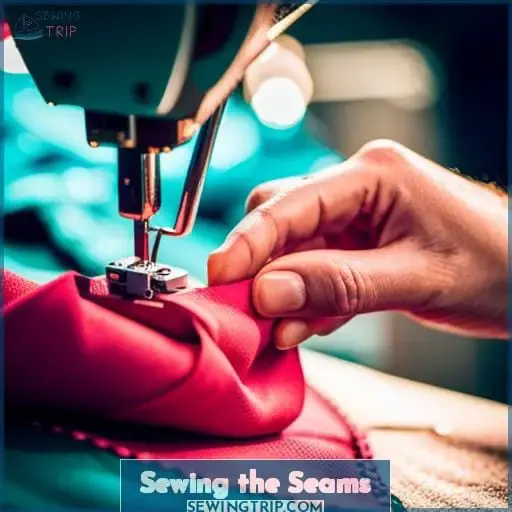This site is supported by our readers. We may earn a commission, at no cost to you, if you purchase through links.
 Imagine the satisfaction of wearing a swimsuit that you made yourself. You have complete control over the design, fit, and fabric choice.
Imagine the satisfaction of wearing a swimsuit that you made yourself. You have complete control over the design, fit, and fabric choice.
With our step-by-step guide on how to make a swimsuit, you’ll be able to create your own stylish and flattering swimwear in no time.
Whether you’re an experienced sewer or just starting out, we’ve got tips and tricks that will help you master this empowering skill.
Get ready to dive into the world of DIY swimwear!
Table Of Contents
- Key Takeaways
- Getting Started
- Choosing the Right Fabric
- Selecting a Swimsuit Pattern
- Taking Accurate Measurements
- Cutting Out the Pattern Pieces
- Sewing the Seams
- Adding Elastic to the Leg Openings
- Attaching the Straps or Halter
- Finishing the Edges
- Final Touches and Adjustments
- Frequently Asked Questions (FAQs)
- Conclusion
Key Takeaways
- Essential equipment and tools for swimsuit making
- Selecting the right swimsuit fabric
- Stitching seams with care
- Encouraging creativity and empowerment in design
Getting Started
To begin making your own swimsuit, gather all the necessary materials and tools.
Equipment essentials include swimsuit fabric, lining fabric, a swimsuit pattern, fabric scissors, a sewing machine with polyester or wooly nylon thread, ballpoint/stretch needles for delicate fabrics like swimwear material, cotton or rubber elastic, twin needle, optional seam ripper.
Before you start cutting and sewing the pieces together, utilize beginner tips for initial preparations such as folding the fabric in half to ensure symmetrical patterns when placing them on top of each other during layout.
Once you have completed these first steps, it’s time to sew the suit by stitching shoulder straps, side seams, crotch area separately, attaching liner, aligning seams, then basting neck, arm, leg openings with standard basting stitch, ensuring proper fit before moving onto adding elastic using zig-zag stitches, securing folded edges across areas where elasticity is desired, completing essential tools, techniques needed constructing perfect fitting, custom-made swimwear creation.
Choosing the Right Fabric
When choosing the right fabric for your swimsuit, consider these important points:
First, select a smooth and thick fabric that’s both forgiving and fun to sew with.
Additionally, be mindful of working with slippery swimwear fabrics as they may require special handling techniques during construction.
Fabric selection tips
When choosing the right fabric for your swimsuit, consider these key factors:
- Swimsuit durability: Look for a fabric that’s resistant to chlorine and UV rays to ensure longevity.
- Color coordination: Choose colors that complement your skin tone and personal style.
- Texture considerations: Opt for a smooth and comfortable fabric that feels good against the skin.
- Stretch evaluation: Test the stretchiness of the fabric to ensure it will provide enough flexibility while wearing.
Adjusting pattern measurements
You’ll refine a swimsuit pattern’s measurements during the fabric selection process.
When choosing fabric, assess the stretch and drape to determine if the original pattern dimensions require adjustment.
Making slight increases to the waist or hip areas often improves comfort and enhances curves.
Use basic pattern tailoring techniques like slash-and-spread to widen areas needing more ease.
Precisely modify key dimensions for a made-to-measure, custom-fitted swimsuit.
Working with slippery fabric
With swimwear fabric’s propensity for slipperiness, you’ll want to pin it or hand-baste it before feeding it through the machine.
- Use sharp scissors to cut slippery fabric accurately.
- Place tissue paper underneath while cutting for added stability.
- Consider using a walking foot attachment on your sewing machine.
- Increase stitch length and tension slightly when working with slippery fabrics.
- Apply a small amount of clear tape to the bottom of your presser foot for better grip.
Selecting a Swimsuit Pattern
To create a swimsuit, the first step is to select a suitable swimsuit pattern.
Consider the design elements you want in your swimwear and look for patterns that align with your vision.
Pay attention to sizing options, style variations, and any special features like built-in support or adjustable straps.
A well-chosen pattern will serve as the foundation for creating a beautifully fitting and stylish swimsuit that showcases your personal flair in poolside fashion.
RTW swimsuit analysis
Examine the construction of the ready-to-wear swimsuit you’ll use for pattern creation—that’ll provide sewing technique insights.
| Area | Considerations | Outcomes |
|---|---|---|
| Construction | Examine seaming, finishing, elastic application | Insights for your pattern |
| Fabric | Note stretch, drape, opacity | Inform fabric selection |
| Fit | Assess ease through bust, waist, hips | Guide measurement adjustments |
Analyzing the original garment facilitates optimal pattern creation for your custom swimsuit.
Adjustments and measurements
Add 1/4-1/2 inch length to areas with elastic when tracing the swimsuit pattern.
Ensure precise measurements and make necessary pattern alterations for a perfect fit.
Consider fabric qualities and their impact on the final product.
Apply elastic with precision, adjusting its length based on stretchiness.
Achieve mastery in creating a swimsuit that liberates your body while exuding power and style.
Selecting swimsuit fabric
You’ll want to choose a swimsuit fabric that has some stretch and is thick enough to provide adequate coverage while still being comfortable when wet.
Consider factors such as:
- Fabric durability
- Color selection
- Print patterns
- Stretch considerations
- Lining options
Taking Accurate Measurements
Once you have selected a swimsuit pattern, you’ll need to take accurate measurements of your body so the finished swimsuit will have a customized, proper fit.
Have a friend help measure key areas like bust, waist, hips, and inseam using a flexible tape measure. Note any asymmetry for pattern adjustment. Record each measurement precisely without rounding.
Strategize ahead for challenging areas like full busts with tailoring changes like a full bust adjustment.
Compare your measurements against the finished garment measurements on the pattern envelope. Make adjustments to the pattern piece lengths based on your proportions. For example, lengthen or shorten seams to fit your torso and inseam length.
Custom sizing the pattern by blending sizes or grading between sizes achieves an ideal personalized fit.
Cutting Out the Pattern Pieces
Prior to cutting into your swimsuit fabric, you’re gonna want to carefully lay out all the pattern pieces according to the instructions. Precision is paramount when cutting – one false snip could throw the whole suit outta whack.
Start by analyzing the original seams and construction. Make any necessary pattern adjustments based on your measurements and desired ease.
Once your template is perfected, focus! Carefully cut each piece, allowing ample seam allowance. Take it slow and steady, keeping your blades sharp and fabric taut. Cut with conviction along traced lines for flawless edges.
Stay present in each slice – this ain’t mindless busy work, it’s crafting couture! With meticulous cutting, you’ll set yourself up for sewing success.
Sewing the Seams
Stitch together the shoulder straps, side seams, and crotch area carefully for both the front and back panels.
When sewing swimwear, take care to:
- Use polyester thread
- Set stitch length to 3mm
- Check tension settings
This helps the seams withstand chlorine and wear from swimming.
Once stitched, press the seam allowances open.
Then, insert the lining, match seams and pin well.
Baste lines together with loose running stitches before permanently joining panels.
Careful sewing leads to a well-fitting, long-lasting swimsuit.
Adding Elastic to the Leg Openings
Sewing Elastic to Leg Openings
After sewing the seams, you’re ready for the fun part – adding elastic!
Cut about 1-2 inches of 1/4 or 1/2 inch braided elastic per leg opening.
Overlap and stitch the ends securely before pinning evenly along the inner leg seam, adjusting tension so the elastic lies flat when relaxed.
Zigzag stitch to attach it to the wrong side while stretching gently. Use polyester thread and switch to a twin needle for extra strength.
Your custom fit is almost ready to show off!
| Pros | Cons | |
|---|---|---|
| 1/4 inch | Less visible, soft stretch | Can roll, less control |
| 1/2 inch | Controls silhouette better | More visible |
Attaching the Straps or Halter
Steps & Tips:
Your final essential step will be sewing the swimsuit’s straps or halter in place.
Carefully measure the desired strap lengths from the front and back panels to ensure even positioning.
Consider adding interfacing or fold-over elastic to strap ends for stability and structure.
For halter variations, determine optimal strap placements and angles to provide ample support.
Pin straps to the exterior fabric first, adjusting positions as needed.
Then, machine stitch straps to the swimsuit’s interior lining as well, backstitching at start and end for security.
Check straps for comfort and make any length adjustments prior to final topstitching, leaving room for minor future tweaks.
Thoughtfully constructed straps or halters uplift the entire swimsuit.
Finishing the Edges
When finishing the edges, fold them under and sew with a zigzag stitch to prevent fraying.
To create a professional-looking swimsuit, it’s important to pay attention to the details of edge treatments.
Hemming techniques can be used for clean and polished edges.
Seam finishes such as serging or using an overlock stitch can help prevent fraying and add durability to the garment.
Binding methods like bias binding or elastic binding can provide a decorative finish while securing raw edges neatly.
For those looking for extra flair, edge embellishments such as lace trim or decorative stitching can elevate the overall design of your swimsuit.
Experimenting with different edge treatments allows you to showcase your creativity while ensuring that your handmade swimwear stands out in terms of both style and quality craftsmanship.
Final Touches and Adjustments
After finishing the edges, you’ll want to try on your swimsuit and make any needed tweaks for the perfect custom fit.
Pinpoint areas needing adjustment by examining the overall drape and stretch.
Take in side seams or lengthen straps and leg openings to refine the silhouette.
Play with creative embellishments like contrast stitching, beads, or lace to make it your own.
Consider removing bulk from the crotch or bust for comfort.
Tailor the leg openings and adjust strap placement to flatter your figure.
Experiment with different looks – add a skirt, try unusual colors.
Detailing options like piping or velvet ribbons inject personality.
With a few thoughtful tweaks, your handmade swimsuit will move with you flawlessly.
Revel in this labor of love!
Frequently Asked Questions (FAQs)
How do I make adjustments if the swimsuit doesn’t fit properly after sewing it?
If your swimsuit doesn’t fit properly after sewing, make adjustments by altering the side seams or shoulder straps.
Experiment with adding or removing fabric to achieve the desired fit and ensure a comfortable and flattering swimsuit.
How many yards of fabric do I need for an average women’s swimsuit?
You’ll need about 5 yards of fabric for a typical women’s swimsuit.
The exact amount can vary slightly depending on your pattern and size, but 1-5 yards gives enough fabric to cut the panels with a bit of wiggle room.
Focus first on finding fabric with the right stretch, drape and recovery for an ideal fit.
The yardage works itself out.
What is the best way to press seams on swimsuit fabric without damaging it?
To press seams on swimsuit fabric without causing damage, apply gentle heat using a low-setting iron.
Press the seams with smooth strokes, ensuring even distribution of heat.
This preserves the integrity and stretchiness of the fabric while maintaining a professional finish.
What special techniques should be used when sewing swimsuit fabric compared to regular apparel fabrics?
When sewing swimsuit fabric, employ special techniques to ensure optimal results.
Use a stretch needle and polyester or wooly nylon thread for durability.
Secure the fabric with zig-zag stitches and adjust elastic tension accordingly for a perfect fit that empowers your swimwear creations.
Conclusion
Have you designed your dream swimsuit yet? Crafting a swimsuit may seem daunting, but as you can see, it’s achievable with some planning, patience, and the right tools.
Follow these steps to create a flattering, custom-fitted swimsuit you’ll love wearing. With practice, you’ll be an expert at knowing how to make a swimsuit uniquely your own.
Now it’s your turn to unleash your inner designer and sew something sensational!
















